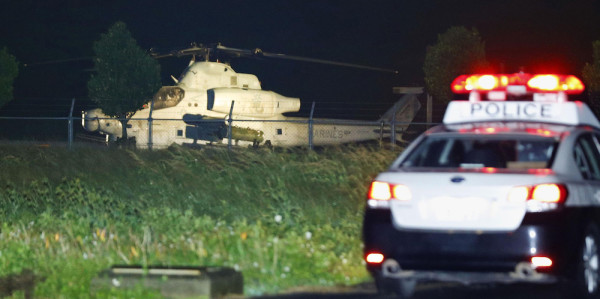

A Marine Corps AH-1 Cobra attack helicopter made an emergency landing Monday on the Japanese island of Okinawa, the Associated Press reports — the second rotary-wing aviation incident for Japan-based Marines since the beginning of the year, and the fourth in a month.
The AH-1 landed in what the Associated Press called “a field at a waste disposal site” in the small town of Yomitan after a warning light alerted the two Marines on board to a potential problem with the helicopter. The Marines told Japanese officials that the descent was a “preventive landing,” according to Stars and Stripes.
The incident came just two days after a rotor issue forced Marine Corps UH-1Y Venom helicopter to make an emergency landing on the small Okinawan island of Ikeijima “after indications that the main rotor was moving at too high a speed,” the Associated Press reported on Jan. 7.
The emergency landing is also the fourth aviation incident for Marines stationed in Japan in just over a month. On Dec. 7, the window of a Marine Corps CH-53E Super Stallions detached from the aircraft and plummeted onto an Okinawa nursery school; earlier that week, another part from a separate Marine helicopter fell from the sky onto a nearby kindergarten.
Japanese authorities were furious after the incidents, with Okinawa Gov. Takeshi Onaga stating that it was “unforgivable” that the incidents nearly killed innocent schoolchildren. But while the 1st Marine Aircraft Wing claimed the nursery school incident was the result of “human error” and pledged to immediately inspect its airframes, the recent emergency landings will likely further fray the nerves of anxious residents.
Related: The Marine Corps’ Aviation Mishap Crisis Is Only Getting Worse »
The grounded Sea Cobra is the latest in a worsening string of Marine aviation mishaps that have wracked the force in the past year. According to the Naval Safety Center, the Marine Corps endured 10 Class A flight mishaps in 2017, the highest rate the branch had recorded in 15 years. The worst incident in came last July, when a KC-130 transporting Marines, sailors, and equipment from Marine Corps Air Station Cherry Point in North Carolina to Naval Air Facility El Centro in California exploded in mid-air over Mississippi, killing the 15 Marines — including six from the Corps’ Special Operations Command — and one Navy corpsman on board.
The concentration of rotary wing incidents in the skies above Japan doesn’t bode well for a fresh start to 2018. In the aftermath of the Jan. 8 incident, Marine 2nd Lt. Gregory Cronen told Stars and Stripes in a statement that the Corps “care deeply for the safety of both our pilots and crew in our aircraft as well as the communities around which we operate.” Something tells me the residents of Okinawa think otherwise.
WATCH NEXT:
